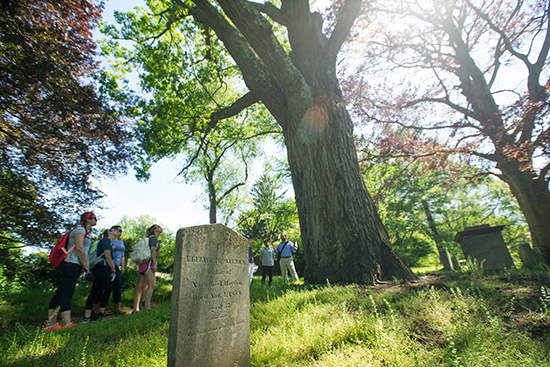One Class, One Day: Reading Mount Auburn Cemetery
Going outdoors to study Boston through green spaces

Students find out how the bucolic surroundings of Mount Auburn Cemetery fit into our social history in a class taught by Charles Ian Stevenson (GRS’13,’19). Photos by Cydney Scott
Class by class, lecture by lecture, question asked by question answered, an education is built. This is one of a series of articles about visits to one class, on one day, in search of those building blocks at BU.
On this warm Tuesday afternoon, the classroom is a place where birds chirp, flowers bloom, and the sun shines on the living and the dead.
At Mount Auburn Cemetery, straddling Cambridge and Watertown, students taking A Walk in the Park: Understanding Boston Through Green Space are walking through green space, and learning about history. On other days, the students enrolled in the Summer I Perspectives on the American Experience course visit Boston Common and the Public Garden, the Esplanade and Franklin Park, Revere Beach, and one of the Harbor Islands.
“You can read all you want about these places,” says instructor Charles Ian Stevenson. “But unless you go to the site and experience it, you’re going to come up short.”
Stevenson (GRS’13,’19) wants students to understand the cultural, social, economic, and political factors that shaped and reshaped our public green spaces. “A lot of the idea of parks in American history and culture was developed in Boston, so the precedent for all these things is here,” he says. Stevenson finds stories about issues like race and class in every acre, which is one reason he wants his students to arrive at the cemetery the same way many Bostonians would have over the years—by public transportation.
He and five undergraduates cross the BU Bridge to Central Square on a #47 bus, switch to the Red Line to Harvard Square, then ride a #73 bus out Mount Auburn Street to the cemetery. The five students from Metropolitan College’s Evergreen Program, open to those 58 and older to audit classes and attend lectures, turn up at the gates on their own.
“We might see a funeral going on, so just be respectful of that,” Stevenson says as the students begin to walk. “They’re still selling plots. This is a very active private cemetery, but it’s open for public enjoyment and has been since 1831.”
Then he asks, “What else have we learned happened in Boston parks in 1831?” A voice from the back calls out an answer. “That’s right,” Stevenson says, “that was the year of no more cows grazing on the Boston Common,” a major change in America’s attitude toward parks.
He leads the way on winding paths through the 170-acre cemetery, whose monumental gravestones, ponds, hills, and plantings draw 200,000 visitors a year. They pass the graves of Henry Wadsworth Longfellow and Winslow Homer. Mary Baker Eddy and Dorothea Dix are here too, along with Buckminster Fuller, Isabella Stewart Gardner, B. F. Skinner, and assorted Lowells and Lodges. (Find a searchable map of grave sites here.) Among the 93,000 graves are 55,000 trees, representing 700 species, many bearing identifying labels. If not for the gravestones, visitors could think they were in an arboretum. That’s not a coincidence.
“This is the first time cemeteries go from being just ragged graveyards with headstones to something that’s more aesthetically landscaped and pleasing,” Stevenson says as the class sits on a shady lawn under a labeled sugar maple.

Back to nature for a day—or an eternity
Mount Auburn, dedicated in 1831, was created mainly by landscape designer Henry A. S. Dearborn, working under the auspices of Boston physician Jacob Bigelow, who is also buried there. In a time of industrialization of America’s cities, Mount Auburn provided a place where you could get away from all that and go back to nature for a day—or an eternity. Bird-watchers have long flocked to its scores of acres. Its healthful, natural atmosphere is a harbinger of the growth in America’s public parks and the suburbanization that was to follow.
“The idea of putting in sculpted landscapes like this, not just cemeteries, but other green spaces, is that they can act as an antidote to the city,” Stevenson says. “Suddenly people start to realize, not only is this nice to go to, but what if you could have this around you all the time?”
He also points out that not everyone could afford to be buried in WASP-y Mount Auburn, or in the slightly more downscale Cambridge Cemetery or the Catholic Mount Auburn Cemetery, also called Sand Banks Cemetery, that flank it.
With a master’s degree in preservation studies, Stevenson is now a doctoral student in BU’s American & New England Studies Program, focused on architectural history, landscapes, and environmental history, especially of the 19th century. His current research concerns communal summer cottages built by Civil War veterans. Generally, he is interested in the way the physical world can be read as a text to explain American culture.
“Unlike an architectural historian, who would be more interested in the formal design of these places,” he says, “I’m interested in the reasons people created these parks, why parks are different from one another, who they were designed to be used by, who actually uses them, and what they can tell us about the way the city has developed.”
The high point of the tour, literally, is a climb up the spiraling staircase of the Washington Tower, which offers a panoramic view of the Boston area, including BU. It is, everyone agrees, a beautiful day.
“I thought, if I have to take a summer class I might as well take one that’s outside,” says Ashley Boitz (COM’17). “I thought it would be a good way to learn about the city I’m studying in, and it’s exceeding my expectations. I feel like every time I’m with my friends walking by something, I’m like, ‘Did you know that…?’ I’m seeing parks differently.”
“I’ve taken Boston architecture,” says Evergreen student Monica Joffe. “I thought this would be a great addition to that, and also it’s a lovely thing to do in the summer.”
When the tour of Mount Auburn is complete, everyone climbs back on a #73 bus and returns to Harvard Square for a visit to the Cambridge Common, where guest speaker and doctoral candidate Sam Shupe (GRS’17) talks about the kind of public recreation spaces designed for the burgeoning working class in the late 1800s. Unlike the cemetery, Shupe says, these parks, which arose at the same time as amusement parks that were anything but pastoral, were friendly to ball-playing, bike-riding, and other activities. “Park spaces reflect the larger cultural and social moods at the time,” he says.
In fact, ball-playing in parks is one reason that Stevenson is interested in the history of green spaces. He grew up in Yonkers, N.Y., and went to a Jesuit high school on the Upper East Side of Manhattan whose gym classes and sports teams used Central Park as their home field.
“How a park functions in the city fabric is something I perceived at an early age,” he says.
This Series
Also in
One Class, One Day
-
November 30, 2018
Breaking Bad Director Gives CAS Class the Inside Dope
-
October 31, 2018
Trump and the Press: We’ve Been Here Before
-
August 3, 2018
A Scholarly Take on Superheroes


Comments & Discussion
Boston University moderates comments to facilitate an informed, substantive, civil conversation. Abusive, profane, self-promotional, misleading, incoherent or off-topic comments will be rejected. Moderators are staffed during regular business hours (EST) and can only accept comments written in English. Statistics or facts must include a citation or a link to the citation.